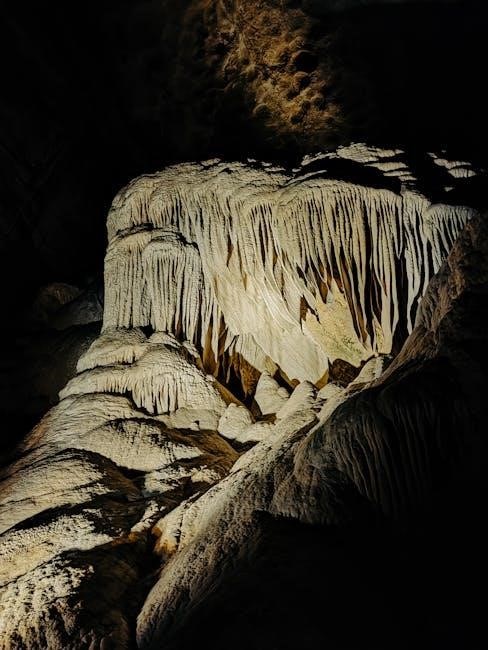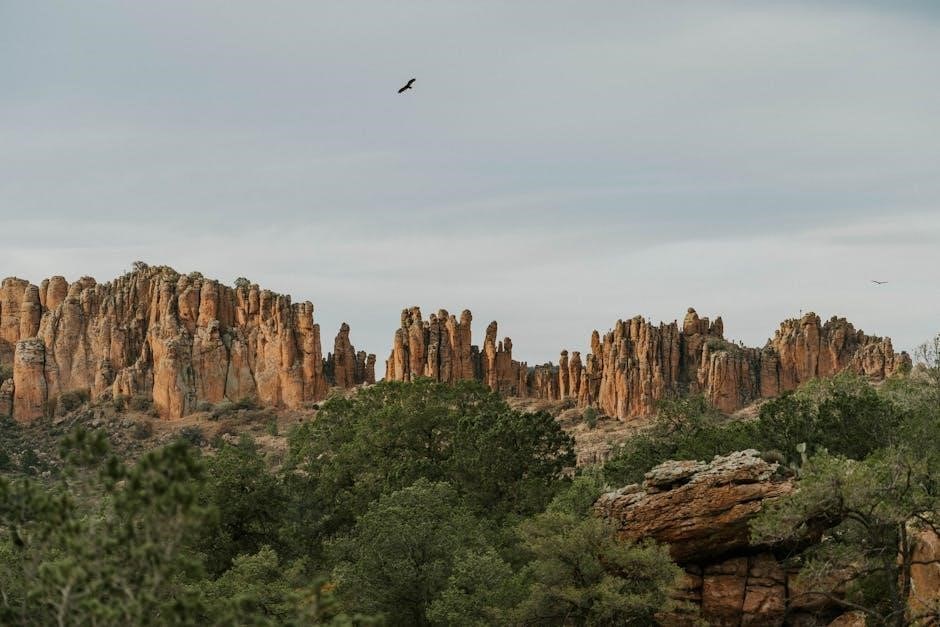National Geographic Rock Tumbler Instructions: A Comprehensive Guide
Unlocking the secrets of rock tumbling with your National Geographic rock tumbler is an exciting journey! This comprehensive guide will provide essential instructions and resources, including links to manuals and troubleshooting tips, ensuring a smooth and successful rock polishing experience.
Overview of National Geographic Rock Tumblers
National Geographic rock tumblers provide an engaging and educational experience, allowing users to transform rough stones into beautifully polished gems. These tumblers are designed for hobbyists and enthusiasts of all ages, offering a hands-on introduction to geological processes. Typically, the kits include the tumbler itself, a selection of rough gemstones, various grades of grit (coarse, medium, fine, and polish), and jewelry fastenings to create unique pieces. The kits also come with a learning guide that provides information about different types of rocks and the science behind the tumbling process. National Geographic offers several models, including hobby and professional versions, each with varying features such as timer settings and noise reduction. The tumblers operate by rotating a barrel containing the rocks, water, and grit. Over several stages, the coarse grit grinds down the rough edges, while the finer grits and polish create a smooth, shiny surface. It’s crucial to follow the included instructions carefully to achieve the best results and avoid common issues like motor overload or grit contamination. Always remember to clean the barrel thoroughly between each grit stage and dispose of used grit properly to prevent plumbing problems;

Preparing for the Tumbling Process
Before starting your rock tumbling adventure, gathering the necessary supplies and preparing your rocks and barrel are crucial steps. Proper preparation ensures optimal results and prevents potential issues during the tumbling process.
Essential Supplies and Materials
To embark on your rock tumbling journey with the National Geographic rock tumbler, you’ll need to assemble a collection of essential supplies and materials. These items will facilitate each stage of the tumbling process, from initial grinding to the final polishing. Here’s a comprehensive list to ensure you’re well-equipped:
- National Geographic Rock Tumbler Kit: This kit typically includes the rock tumbler itself, a variety of rough gemstones, polishing grits (coarse, medium, fine, and polish), jewelry fastenings, and a learning guide.
- Rough Rocks: Select a variety of rocks with different sizes and hardness levels for optimal tumbling results.
- Coarse Grit (60/90 mesh): Used for the initial grinding stage to remove rough edges and shape the rocks.
- Medium Grit (120/220 or 150/220 mesh): Used in the second stage to smooth the rocks further.
- Fine Grit (500 or 600 mesh): Used in the third stage to prepare the rocks for polishing.
- Rock Polish: The final abrasive compound used to create a glossy, smooth finish on the rocks.
- Ivory Bar Soap: Used for cleaning the rocks and barrel between stages.
- Plastic Colander: For rinsing the rocks and separating them from the grit.
- Plastic Bucket: For washing the rocks and barrel.
- Tablespoon: For measuring grit.
- Toothbrush: For scrubbing the rocks and barrel.
- Safety Glasses: To protect your eyes from dust and debris.
- Garden Hose: For washing the rocks and barrel outside.
Having these supplies on hand will ensure a smooth and efficient rock tumbling process, allowing you to transform rough stones into beautiful, polished gems.
Rock Selection and Barrel Preparation
Before you begin the tumbling process with your National Geographic rock tumbler, careful rock selection and proper barrel preparation are crucial for achieving the best possible results. Here’s a detailed guide to ensure you start off on the right foot:
Rock Selection:
- Choose a Variety: Select rocks with a mix of sizes and hardness levels. This will help ensure that all rocks are evenly ground and polished.
- Similar Hardness: Ideally, rocks in the same batch should have similar hardness to prevent softer stones from wearing away too quickly.
- Avoid Soft Rocks: Rocks that are too soft, such as shale or chalk, may disintegrate during the tumbling process.
- Clean the Rocks: Before loading the rocks into the barrel, remove any dirt or debris. A quick rinse with water and a scrub with a brush can do the trick.
Barrel Preparation:
- Clean the Barrel: Ensure the barrel is completely clean before each stage of tumbling. Any leftover grit or rock fragments from a previous tumble can contaminate the current batch and lead to scratches;
- Check for Damage: Inspect the barrel for any cracks or damage. A damaged barrel can leak and compromise the tumbling process.
- Proper Filling: Fill the barrel about 1/2 to 2/3 full of rocks. Overfilling the barrel can prevent the rocks from moving freely, while underfilling can lead to excessive wear on the rocks and barrel.
- Barrel and Lid Cleanliness: Make sure the rim of the barrel and the lid are totally free from grit or rock particles to prevent leaks.
By carefully selecting your rocks and properly preparing the barrel, you’ll set the stage for a successful and rewarding rock tumbling experience.

Step-by-Step Tumbling Instructions
Follow these detailed steps to transform rough stones into polished gems using your National Geographic rock tumbler. Each stage requires specific grit and tumbling times for optimal results. Let’s get started!
Coarse Grit Stage
The coarse grit stage is the foundation of the rock tumbling process. This initial step shapes and smooths your rough rocks, removing sharp edges and imperfections.
- Preparation: Ensure your tumbler barrel is clean and free from any residual grit or debris. This prevents contamination and ensures the coarse grit works effectively.
- Loading the Barrel: Fill the barrel approximately 1/2 to 2/3 full with your selected rough rocks. A mix of sizes promotes better tumbling action. Avoid overloading, as this can hinder the tumbling process and potentially damage the motor.
- Adding Coarse Grit: Add the appropriate amount of coarse grit (typically 60/90 mesh) to the barrel. Refer to your National Geographic rock tumbler manual for specific grit-to-rock ratios.
- Adding Water: Add water to the barrel until the water level just covers the top of the rocks.
- Tumbling Time: Seal the barrel securely and place it on the tumbler. Tumble for 7-10 days, or as recommended in your manual. Check the rocks periodically (every 1-2 days) and add water if needed to maintain the water level.
- Cleaning: After the coarse grit stage, thoroughly clean the rocks and the barrel to remove all traces of the coarse grit. Use a plastic colander and a garden hose for best results. Never pour used grit down any household drain, as it can cause plumbing problems.
Important Notes:
- The coarse grit stage is the longest and most crucial stage. Be patient and allow sufficient time for the rocks to be properly shaped.
- If the tumbler is overloaded, the built-in sensor may automatically protect the motor by turning the tumbler off. If this happens, remove some rocks, unplug the tumbler, and plug it in again to reset it.
Medium and Fine Grit Stages
Following the coarse grit stage, the medium and fine grit stages refine the shapes and surfaces of your rocks, preparing them for the final polishing stage. These stages involve similar steps but with progressively finer grits.
- Cleaning: Thoroughly clean the rocks and the tumbler barrel after each grit stage to prevent contamination from the previous grit. This ensures the next grit works effectively. Use a plastic colander and a garden hose for best results, and never pour used grit down household drains.
- Medium Grit Stage: Place the cleaned rocks back into the barrel and add the appropriate amount of medium grit (typically 120/220 or 150/220 mesh), following the instructions in your National Geographic rock tumbler manual. Add water until it just covers the rocks. Tumble for approximately 5-7 days, checking the water level periodically.
- Fine Grit Stage: After the medium grit stage, clean the rocks and barrel again. Then, add the rocks back into the barrel with the correct amount of fine grit (typically 500 or 600 mesh) and water. Tumble for another 5-7 days, monitoring the water level.
Important Considerations:
- Inspection: After each stage, inspect the rocks. If you see any deep scratches or imperfections, consider returning them to the previous stage for further tumbling.
- Grit Contamination: Preventing grit contamination is crucial. Use separate containers and cleaning tools for each grit stage to avoid mixing grits.
- Water Level: Maintain the proper water level throughout each stage. The water acts as a lubricant and helps to distribute the grit evenly.
- Timer Settings: Use the one-touch settings on your National Geographic rock tumbler to control the number of days for each tumbling cycle.
Polishing Stage and Final Steps
The polishing stage is the final step in the rock tumbling process, where the rocks achieve their lustrous shine. After this stage, a few final steps ensure your polished rocks are ready for display or use.
- Cleaning: As with previous stages, thoroughly clean the rocks and the tumbler barrel. Any remaining fine grit can contaminate the polishing stage and reduce the shine. Use a plastic colander and plenty of water to remove all traces of grit.
- Polishing Stage: Place the cleaned rocks into the barrel and add the recommended amount of rock polish (often a very fine powder). Add water until it just covers the rocks. Tumble for 5-7 days.
- Burnishing (Optional): For an extra shine, consider a burnishing step. After polishing, clean the rocks and barrel. Add the rocks back into the barrel with a small amount of Ivory bar soap (flakes) and water. Tumble for 1-2 days. This step helps remove any remaining polish residue and enhances the luster.
- Final Cleaning: After the polishing or burnishing stage, give the rocks a final, thorough cleaning. Use a soft brush or cloth to remove any remaining residue.
- Drying and Inspection: Lay the rocks out on a clean surface to dry. Once dry, inspect each rock carefully. The rocks should have a smooth, shiny surface.
- Display or Use: Your polished rocks are now ready to be displayed, used in crafts, or added to a collection.
Tips for a Successful Polish:
- Patience: The polishing stage requires patience. Allow the rocks to tumble for the full duration to achieve the best results.
- Polish Quality: Use a high-quality rock polish specifically designed for rock tumbling.
- Cleanliness: Maintaining cleanliness throughout the polishing stage is essential for achieving a brilliant shine.

Troubleshooting and Maintenance
Like any mechanical device, your National Geographic rock tumbler may encounter issues over time. Proper maintenance and knowing how to troubleshoot common problems will extend the life of your tumbler and ensure consistent results.
Common Issues and Solutions
Tumbler Not Turning On: First, ensure the tumbler is properly plugged into a working outlet. Check for any tripped circuit breakers; If the tumbler has an overload protection feature, it may have been triggered if the barrel was overfilled. Remove some rocks, unplug the tumbler, and plug it back in to reset it.
Leaking Barrel: Make sure the barrel lid and rim are clean and free of grit particles. Even small particles can prevent a tight seal. Inspect the rubber gasket for any damage or wear and replace if necessary. Ensure the lid is securely tightened.
Rocks Not Polishing: This can be due to several factors; Ensure you are using the correct grit for each stage and that you are following the recommended tumbling times. Make sure the barrel is filled to the appropriate level (about 1/2 to 2/3 full). Insufficient grit or too much water can also affect polishing.
Excessive Noise: A noisy tumbler can indicate that the barrel is not properly balanced. Try rearranging the rocks inside the barrel. Also, check for any loose parts or debris inside the tumbler mechanism.
Motor Overheating: If the motor overheats, it may shut off automatically. Allow the motor to cool down completely before restarting. Avoid overloading the tumbler, as this can strain the motor.
Grit Contamination: Always thoroughly clean the barrel and rocks between each grit stage to prevent contamination. Even a small amount of coarser grit can scratch the rocks in the finer stages. Use a plastic colander and garden hose for rinsing.
Barrel Wear and Tear: Inspect the barrel regularly for signs of wear, such as cracks or deformation. Replace the barrel if it becomes damaged to prevent leaks and ensure proper tumbling action.

Safety Precautions
Operating a rock tumbler involves certain safety considerations to protect yourself and your environment. Always wear safety glasses when handling rocks, grit, and during any stage of the tumbling process to prevent particles from entering your eyes. It’s also recommended to wear gloves to protect your hands from the abrasive nature of the grit and prolonged exposure to water.
When handling grit, avoid creating dust clouds, as inhaling grit particles can be harmful to your respiratory system. Work in a well-ventilated area or wear a dust mask. Never dispose of used grit down household drains, as it can cause significant plumbing problems. Instead, collect the used grit and dispose of it properly in a sealed container in accordance with local regulations.
Keep the rock tumbler out of reach of children and pets, and always supervise children when they are involved in the rock tumbling process. Ensure the tumbler is placed on a stable, level surface to prevent it from tipping over during operation. Before starting the tumbler, double-check that the barrel is securely closed and properly aligned to prevent leaks or spills.
Regularly inspect the power cord for any damage and avoid using the tumbler if the cord is frayed or damaged. Always unplug the tumbler before cleaning or performing any maintenance. Do not immerse the tumbler base in water or any other liquid. If any electrical components become wet, unplug the tumbler immediately and allow it to dry completely before using it again. By following these safety precautions, you can enjoy rock tumbling safely and effectively.
